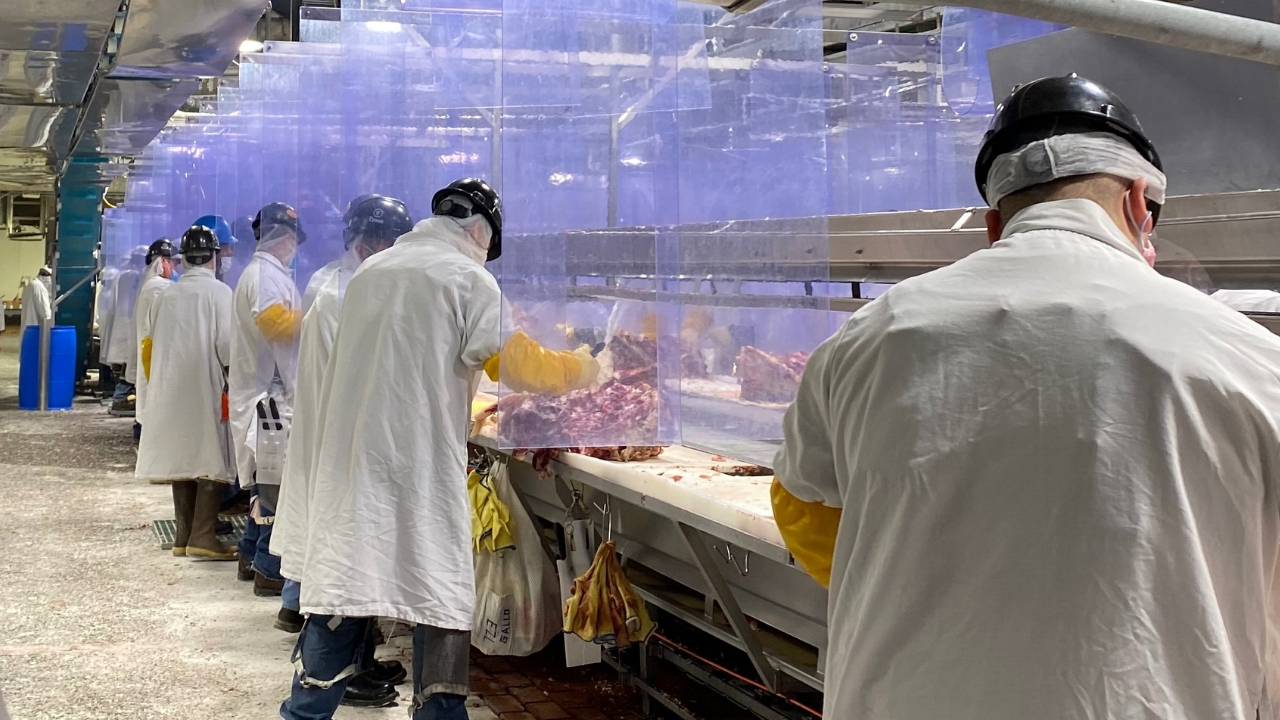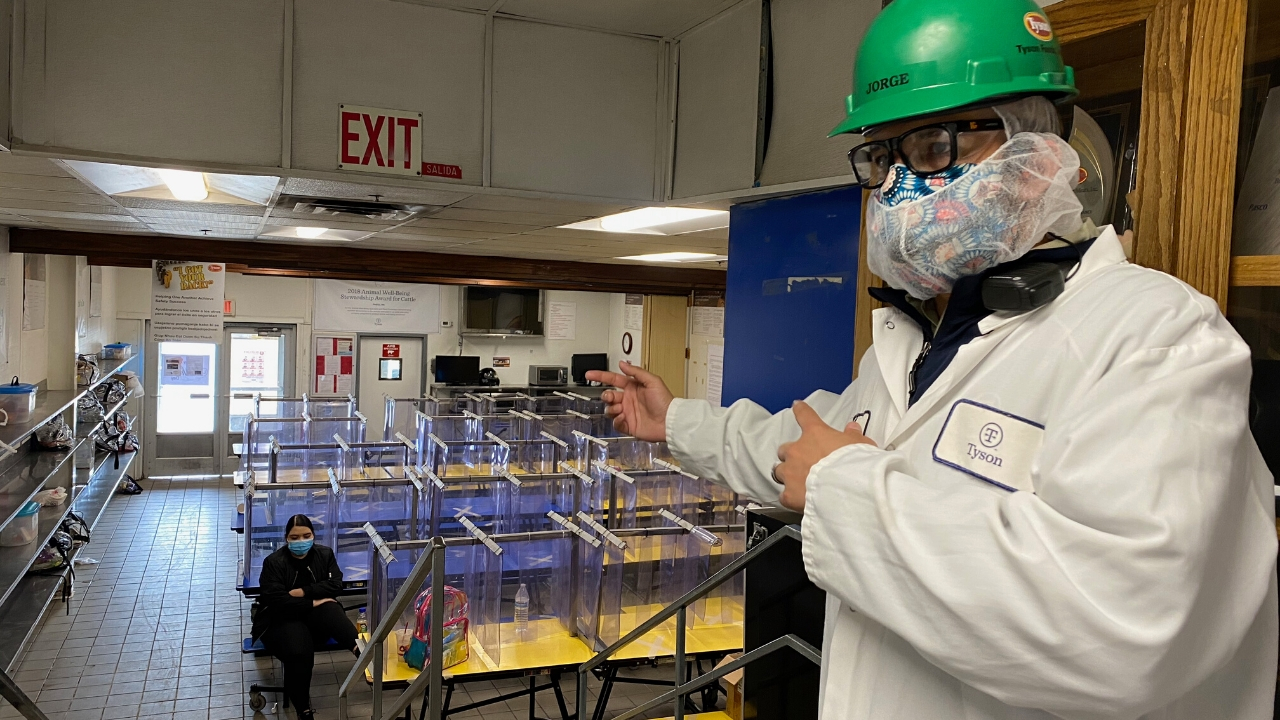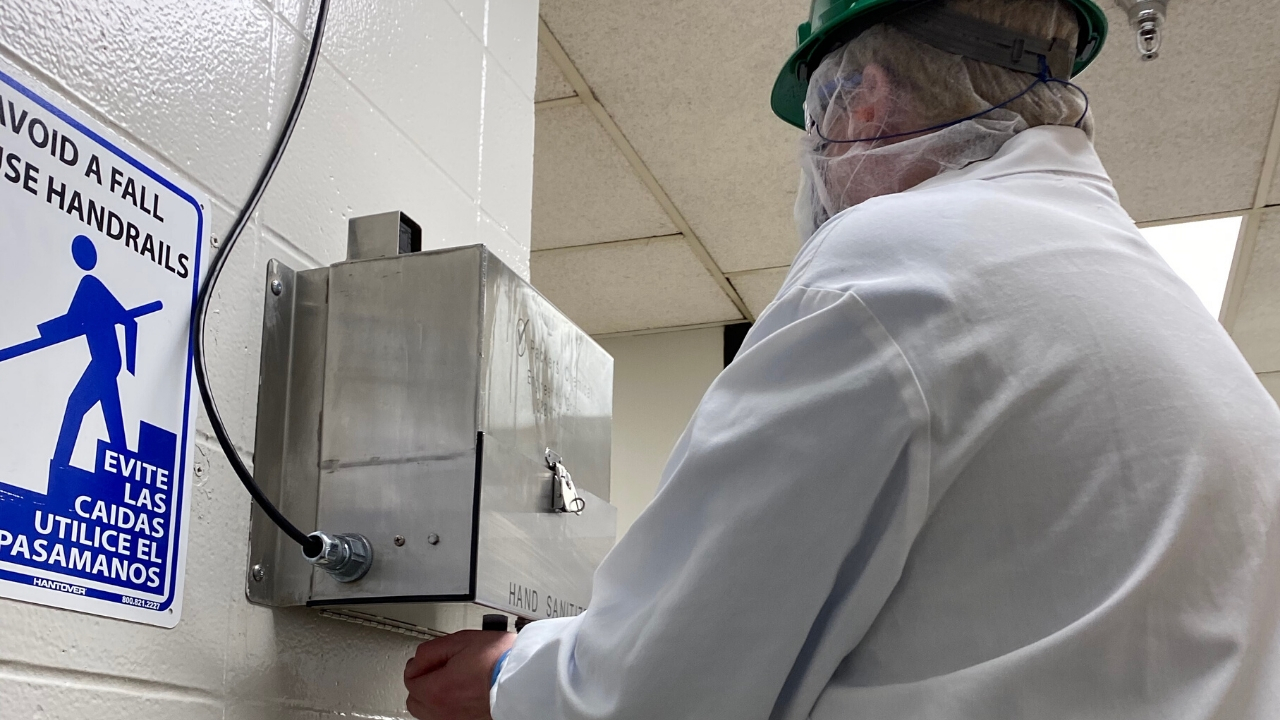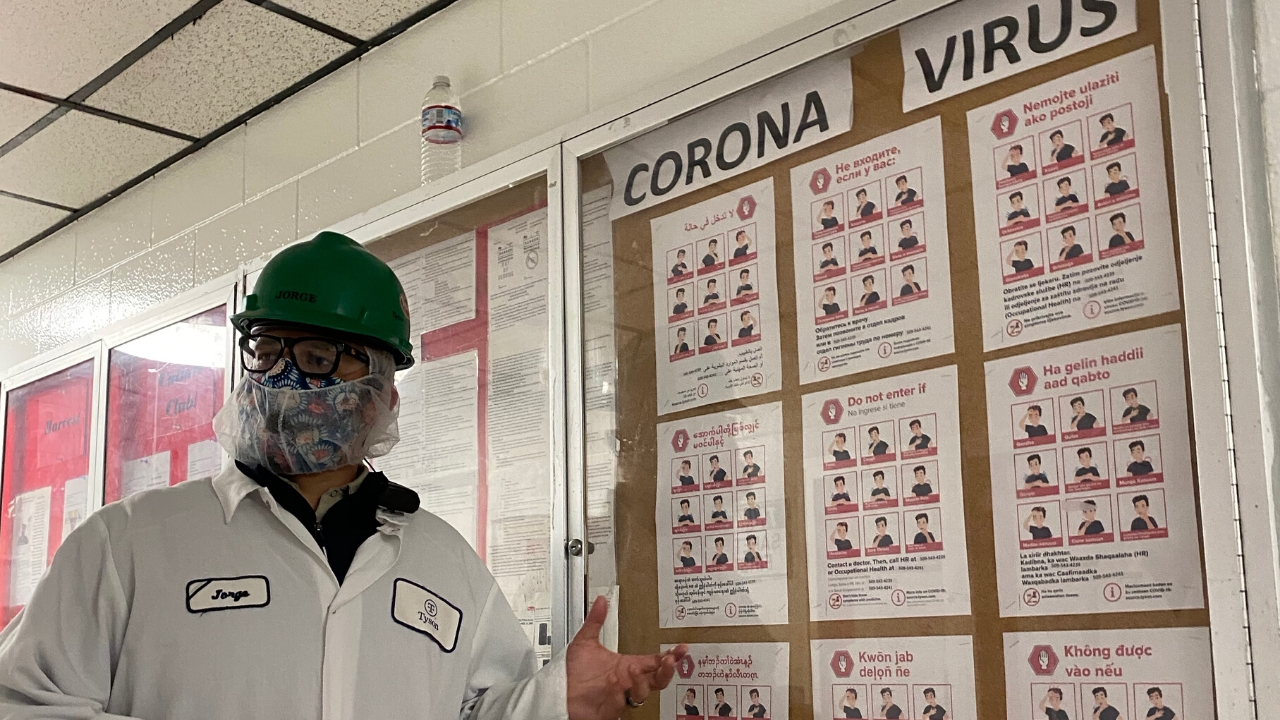i toured a beef processing plant during covid-19
WABEEF | May 22, 2020
On May 12, The Washington State Beef Commission was invited to Tyson Foods’ Washington beef processing plant to see how the environment and operations have changed during the COVID-19 pandemic, and they invited me and my iPhone camera along.
When our small group of Washington beef and agriculture representatives arrived at the facility in Wallula, Wash., plant manager Brad Anderson greeted us. We awkwardly avoided shaking hands. We masked up and made small talk about the cattle markets and how things are going right now as we waited for Washington State Department of Agriculture Director Derek Sandison to join us. I hadn’t been out and about enough since Mid-March to actually wear a mask yet. I probably should have given this a dry run. I gauged how much my glasses might fog up when I tried to speak and attempted to adjust both without touching my face.
I've toured this plant, and the other large beef processing plant in Toppenish several times under normal circumstances. I was eager to see the changes designed to address COVID-19 risk to employees.
At the plant check-in, we signed in, provided our identification and proceeded through a temporary tent where everyone entering – employees, contractors, or guests like us, are given a temperature screening. No one with a temperature at or above 100.4 degrees Fahrenheit may enter the facility.
Washington State Department of Agriculture Director Derek Sandison enters the facility through the mandatory temperature and symptom screening tent at the Tyson Foods beef processing plant in Wallula, Wash. May 12, 2020.
If an employee reporting for their shift has a high fever, or other symptoms, they proceed to the Matrix Medical Network mobile health screening unit located right outside the plant door. This third-party medical screening provider then makes the determination if the employee should resume work, go home, or be assisted in contacting a healthcare provider, taking the decision out of the plant’s hands. At the end of April, the entire facility was suspended for about two weeks to accommodate COVID-19 testing of the entire facility’s workforce – roughly 1,480 employees and contractors. This testing, combined with workers being tested through their healthcare providers, resulted in 277 positive cases. Over half of those who tested positive did not display any symptoms, and over half are classified as recovered. Among these results, sadly there have been three COVID-19 linked deaths of Tyson plant workers. Employees who test positive are provided paid leave and may return to work only when CDC and Tyson criteria are met.
While the plant was down for testing, Tyson worked with the Walla Walla County Department of Community Health (WWCDCH) to implement additional protective measures plant-wide. The plant resumed limited operations on Tuesday, May 5. Production ramped up slowly the first week but is gradually increasing as more healthy team members return to work.
Operations Manager Jorge Guzman guided us through the entire plant. We noticed messages scrolled by employees on vertical stainless steal surfaces all throughout, reminding each other to take new precautions to be safe.
Operations Manager Jorge Guzman was our tour guide. We donned our white frocks, helmets, hair nets, and one earplug. On the other side, I slipped an earpiece around my ear somewhere under the layers of protective gear, connected to a small receiver that reminded me of an iPod Shuffle. This audio allowed us to hear Jorge, through a mask, over the din of processing equipment, without needing to be close to each other. Even our tour was designed with social distancing in mind.
An uncommonly empty boxed beef shipping area is the result of the plant's recent shutdown for COVID-19 testing of all employees and installation of new protective equipment around the facility.
We began our tour where boxed beef awaits shipment to customers. I didn’t need to hear Jorge’s explanation of what we saw. The three-level cold storage facility felt empty. Because it was. The space can house 50,000 boxes, but the pre-shipment inventory of beef boxes totaled only about 8,000 this day. These empty racks were the result of the slower processing volumes and suspended production due to testing and additional sanitizing and cleaning. The gaps in the beef supply shoppers are seeing in grocery store meat cases is a direct result of the effort to fight the spread of COVID-19 in processing plants across the nation, while still getting beef to the market. While it’s not ideal for any beef processing plant to be offline or slowed, the team at Tyson is clear eyed to purpose: to keep their workforce safe and healthy. Anderson summed it up,
"Team member safety is top priority around here, now and always."
Throughout our tour and conversations with employees, we noted well over a dozen significant changes in the facility and operations, designed to address the COVID-19 risk to their employees and mitigate it. Similar strategies are being executed by the other major beef processing plant in Washington, and all of the beef processing facilities across the country:
- The plant has reduced shift length from ten hours to eight hours, to limit the length of potential exposure between staff who work side by side. Shift changes are staggered to avoid crowding in the spaces where employees access the plant to begin their work.
- All employees are wearing masks and eye protection. Clear vinyl partitions are installed between every work space on the cutting floor. In areas where installation of this safety equipment is unfeasible, employees wear full face shields over their masks. The partitions are installed in the cafeteria and break areas as well. Additional hand sanitizer stations are installed all over the facility. The plant is in the process of converting to all touchless dispensers.
- “Social distancing monitors” recommended by the Walla Walla County Department of Community Health, are tasked with reminding employees not to congregate closely together between shifts and on breaks. Masks are provided and employees, often family members who carpool together, are encouraged to wear them while commuting to and from work inside shared vehicles.
- At least 18 new positions were created and dedicated to wiping down and sanitizing common areas (cafeterias, break rooms, locker rooms, bathrooms, etc). There are temporary additional break and lunch tents outside, featuring vinyl-partitioned tables, where construction of a permanent expansion of break areas is underway.
- The temperature check station at the plant entrance, currently under a temporary tent, screens everyone entering the facility. Construction of a permanent building to house an infrared walk-through temperature scanner is underway. During this process, Tyson also conducts wellness checks to screen for symptoms, such as coughing and shortness of breath.
- Working with State Labor & Industries, the company has posted signage on the walls and screens throughout the building most visible to employees. Coronavirus-awareness and safety information is posted in at least a dozen different languages spoken by employees who work here. Additionally, infographics were created and provided by their Corporate offices to account for different dialects of workers coming from different countries. The Walla Walla County Department of Community Health has offered to help create videos to continue employee awareness and education about COVID-19.
- The company doubled the amount of its “Thank You” bonus, in an acknowledgement of the risk employees are taking to perform the essential duty to keep beef moving into the food supply. Team members who cannot come to work because of illness or childcare issues related to COVID-19 will continue to qualify. Tyson Foods also increased short-term disability coverage to 90% of normal pay until June 30 to encourage team members to stay home when they are sick. On-site third-party health screenings are available to all workers who have concerns about their health.
We wondered how employees working there felt about their own health and safety and the changes being implemented. We spoke with Ariana near her post in the specialty ground beef patty processing area about the changes and how she feels about being at work inside the plant.
"I’m glad to be back at work. I feel comfortable and safe. I like how I see people here staying distanced from each other and wearing their masks."
But not all employees are comfortable with showing up to work in the middle of a pandemic. Human Resources Manager David Tobias said roughly 10 percent of the regular workforce is not reporting for duty for any number of reasons, fear being one. As we walked down the line where beef chucks (the shoulder area) are deboned, an advanced knife-skillset position, some partitioned stations were noticeably empty.
It’s hard to say what will make all workers feel ready and willing to come into the plant and do their jobs without hesitation or fear. The new health and safety measures will be monitored and evaluated to determine if it is enough to keep workers healthy. The Walla Walla County Department of Community Health has an open door to visit and inspect the plant without appointment or pre-notification. The bottom line of all this investment and collaboration between beef companies, public health authorities, and lawmakers is that it must result in a real reduction in the risk and danger to the workforce. Looking long term, it’s likely many of these health precautions will become permanent.
“We want to instill confidence in our employees that they’re returning to a safe work environment,” said Anderson. “We’re also grateful for the support from local health officials and all who have helped keep our team members and communities safe.”
If beef processing companies and public health authorities cannot figure this out, it paints a grim picture for both consumers and the farmers and ranchers who raise beef. This presents a unique challenge to the market for beef cattle in the fall, when many Pacific Northwest ranchers are ready to sell their calves after they have grazed all summer. The cattle that cannot be harvested today because of the processing slowdown will still be taking up space in cattle finishing feed yards, narrowing the marketing opportunities for the animals ready to move up the chain.
While what’s happening here at the plant, and meat processing facilities across the country has a circular ripple out to consumers and the supply chain, the tour and the focus here at the plant is on the issue at hand – employee safety from COVID-19 while continuing operations. The journey of beef as a food is a great example of how we are all linked. While we’re enveloped in an ongoing public health and economic crisis where we don’t know what comes next, the least, even perhaps the most we can do right now is to just be thankful and acknowledge that there are people showing up to do the work it takes to get food like beef to us each day.
***
- Bridget Coon
Bridget is an eastern Washington beef cattle rancher, mom, and digital media consultant for the Washington State Beef Commission




